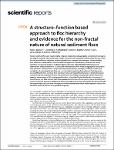A structure–function based approach to floc hierarchy and evidence for the non-fractal nature of natural sediment flocs
| dc.contributor.author | Spencer, KL | |
| dc.contributor.author | Wheatland, JAT | |
| dc.contributor.author | Bushby, AJ | |
| dc.contributor.author | Carr, SJ | |
| dc.contributor.author | Droppo, IG | |
| dc.contributor.author | Manning, Andrew | |
| dc.date.accessioned | 2023-05-05T00:04:46Z | |
| dc.date.available | 2023-05-05T00:04:46Z | |
| dc.date.issued | 2021-07-07 | |
| dc.identifier.issn | 2045-2322 | |
| dc.identifier.issn | 2045-2322 | |
| dc.identifier.other | 14012 | |
| dc.identifier.uri | https://pearl.plymouth.ac.uk/handle/10026.1/20809 | |
| dc.description.abstract |
Natural sediment flocs are fragile, highly irregular, loosely bound aggregates comprising minerogenic and organic material. They contribute a major component of suspended sediment load and are critical for the fate and flux of sediment, carbon and pollutants in aquatic environments. Understanding their behaviour is essential to the sustainable management of waterways, fisheries and marine industries. For several decades, modelling approaches have utilised fractal mathematics and observations of two dimensional (2D) floc size distributions to infer levels of aggregation and predict their behaviour. Whilst this is a computationally simple solution, it is highly unlikely to reflect the complexity of natural sediment flocs and current models predicting fine sediment hydrodynamics are not efficient. Here, we show how new observations of fragile floc structures in three dimensions (3D) demonstrate unequivocally that natural flocs are non-fractal. We propose that floc hierarchy is based on observations of 3D structure and function rather than 2D size distribution. In contrast to fractal theory, our data indicate that flocs possess characteristics of emergent systems including non-linearity and scale-dependent feedbacks. These concepts and new data to quantify floc structures offer the opportunity to explore new emergence-based floc frameworks which better represent natural floc behaviour and could advance our predictive capacity. | |
| dc.format.extent | 14012- | |
| dc.format.medium | Electronic | |
| dc.language | en | |
| dc.publisher | Springer Science and Business Media LLC | |
| dc.title | A structure–function based approach to floc hierarchy and evidence for the non-fractal nature of natural sediment flocs | |
| dc.type | journal-article | |
| dc.type | Journal Article | |
| dc.type | Research Support, Non-U.S. Gov't | |
| dc.type | Research Support, U.S. Gov't, Non-P.H.S. | |
| plymouth.author-url | https://www.ncbi.nlm.nih.gov/pubmed/34234234 | |
| plymouth.issue | 1 | |
| plymouth.volume | 11 | |
| plymouth.publication-status | Published online | |
| plymouth.journal | Scientific Reports | |
| dc.identifier.doi | 10.1038/s41598-021-93302-9 | |
| plymouth.organisational-group | |Plymouth | |
| plymouth.organisational-group | |Plymouth|Research Groups | |
| plymouth.organisational-group | |Plymouth|Faculty of Science and Engineering | |
| plymouth.organisational-group | |Plymouth|Faculty of Science and Engineering|School of Biological and Marine Sciences | |
| plymouth.organisational-group | |Plymouth|Research Groups|Marine Institute | |
| plymouth.organisational-group | |Plymouth|REF 2021 Researchers by UoA | |
| plymouth.organisational-group | |Plymouth|Users by role | |
| plymouth.organisational-group | |Plymouth|Users by role|Academics | |
| plymouth.organisational-group | |Plymouth|REF 2021 Researchers by UoA|UoA07 Earth Systems and Environmental Sciences | |
| dc.publisher.place | England | |
| dcterms.dateAccepted | 2021-06-11 | |
| dc.date.updated | 2023-05-05T00:04:46Z | |
| dc.rights.embargodate | 2023-8-5 | |
| dc.identifier.eissn | 2045-2322 | |
| dc.rights.embargoperiod | forever | |
| rioxxterms.versionofrecord | 10.1038/s41598-021-93302-9 |


